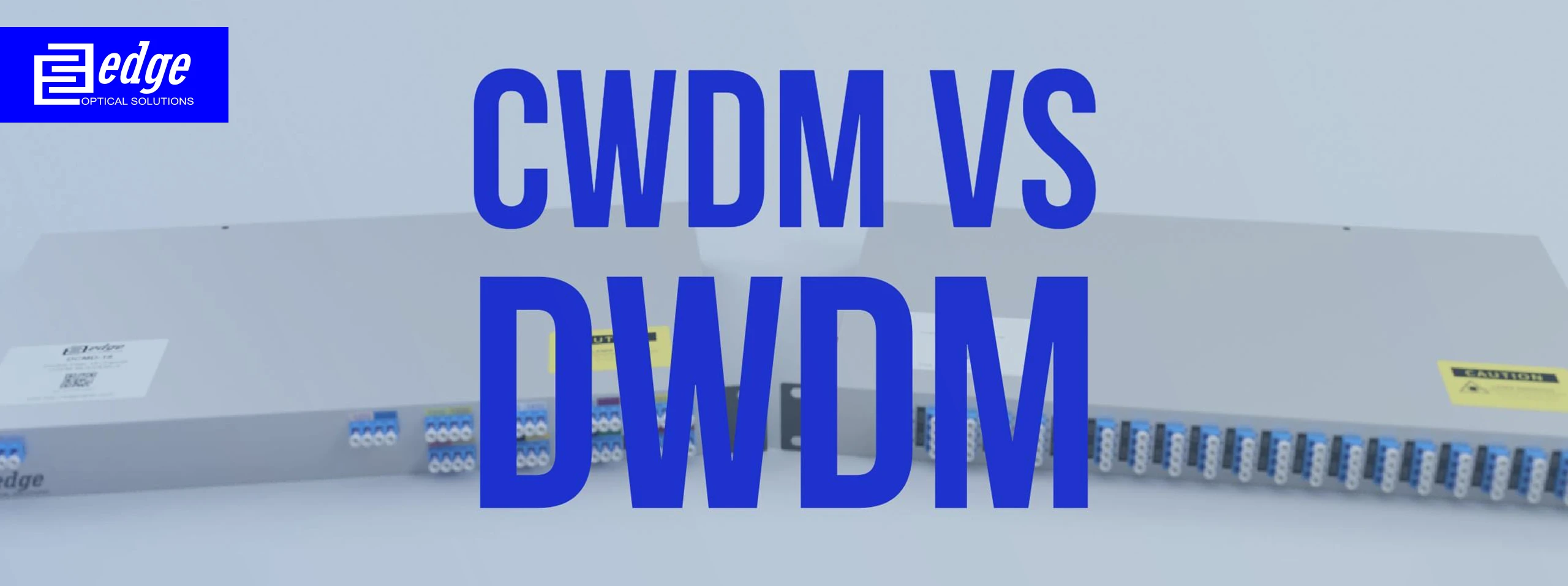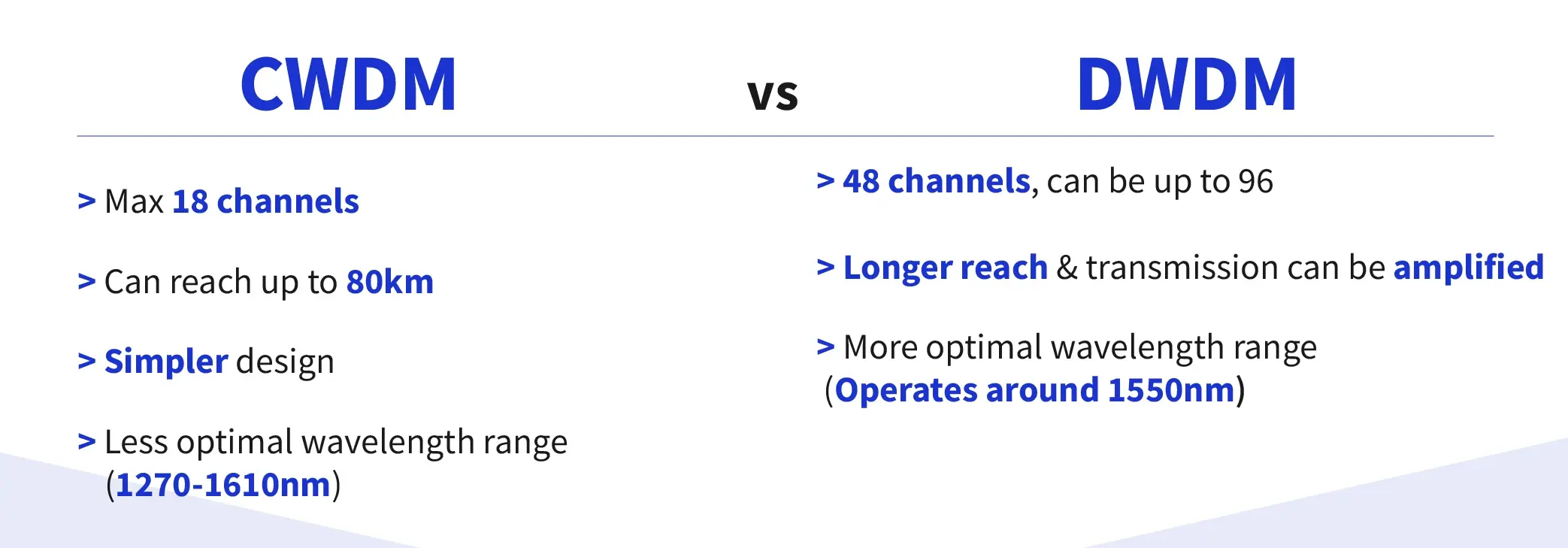
CWDM vs DWDM: a Comprehensive Guide in Understanding Differences
There exist two primary categories of Wavelength Division Multiplexing (WDM) systems: Coarse Wavelength Division Multiplexing (CWDM) and Dense Wavelength Division Multiplexing (DWDM). Both CWDM and DWDM are contemporary WDM technologies employed to increase fiber bandwidth by consolidating optical signals with varying wavelengths onto a single fiber strand. However question arises: what are the differences between CWDM and DWDM?
- WDM, CWDM and DWDM: Introduction
- Main Differences
- CWDM vs DWDM: Advantages and Disadvantages
- CWDM vs DWDM: Frequently Asked Questions
WDM, CWDM and DWDM: Introduction
What is a wavelength?
A wavelength refers to the distance between two consecutive points of a wave. In the context of telecommunications and optical networking, it is typically expressed in nanometers (nm), to indicate the properties of an optical signal.
What is wavelength division multiplexing (WDM)?
Wavelength division multiplexing (WDM) is a technique used in telecommunications and optical networking to increase the capacity of fiber optic communication systems. It involves the simultaneous transmission of multiple optical signals, each at a different wavelength, over one optical fiber. By utilizing different wavelengths, WDM allows for the efficient utilization of the available bandwidth, enabling multiple data streams to be transmitted simultaneously without interference. This technology significantly increases the data transmission capacity of optical networks and eliminates the need for additional fiber cables, thereby facilitating the rapid and efficient transfer of large amounts of information.
What Is CWDM?
Coarse Wavelength Division Multiplexing (CWDM) allows multiple signals to be transmitted simultaneously over one optical fiber by using different wavelengths of light to carry each signal. CWDM operates in the wavelength range of 1270nm to 1610nm, with each CWDM channel typically separated by 20nm.

There are a total of 18 CWDM channels – initial technology was developed for 9 (1470-1610) channels, and was later expanded to 18 channels that include lower wavelength channels with less effective attenuation. The below table shows the standard channel pairing in CWDM setups.
| CWDM Channels | |||
|---|---|---|---|
| Nominal central wavelengths (nm) | Latch color by wavelength | BIDI Pair | Side |
| 1271 | 1 | A | |
| 1291 | B | ||
| 1311 | 2 | A | |
| 1331 | B | ||
| 1351 | 3 | A | |
| 1371 | B | ||
| 1391 | 4 | A | |
| 1411 | B | ||
| 1431 | 5 | A | |
| 1451 | B | ||
| 1471 | 6 | A | |
| 1491 | B | ||
| 1511 | 7 | A | |
| 1531 | B | ||
| 1551 | 8 | A | |
| 1571 | B | ||
| 1591 | 9 | A | |
| 1611 | B | ||
What Is DWDM?
Dense Wavelength Division Multiplexing (DWDM) enables the transmission of multiple data signals simultaneously over one optical fiber by dividing the available bandwidth into numerous wavelengths or channels. DWDM operates in the following wavelength ranges:

DWDM operates with a much narrower channel spacing of 100Ghz or less. For the full list of DWDM channels you can check out our DWDM channel chart.
What is CWDM and DWDM’s purpose?
The purpose of CWDM (Coarse Wavelength Division Multiplexing) and DWDM is to increase the capacity and efficiency of fiber optic networks by allowing multiple signals to be transmitted simultaneously over a single optical fiber.
CWDM vs DWDM: Main Differences

CWDM vs DWDM: Applications
CWDM is typically used for short-distance applications, such as metropolitan area networks (MANs) or campus networks, where the transmission distance is limited. It utilizes wider channel spacing, allowing for a smaller number of wavelengths to be multiplexed. On the other hand, DWDM has more advantages in long-haul applications, such as backbone networks or submarine cables, where the transmission distance is much greater.
CWDM vs DWDM: Transmission capacity
Due to the difference in channel spacing, DWDM can support a significantly higher number of channels compared to CWDM, resulting in a much higher transmission capacity. DWDM systems can support as many as 96 channels, while CWDM systems typically support up to 18 channels.
CWDM vs DWDM: Transmission Distance
CWDM operates over shorter distances, typically up to 80 kilometers. On the other hand, with amplification and dispersion compensation, DWDM offers significantly greater transmission distances that with amplification can exceed several hundred kilometers.
CWDM vs DWDM: Cost
The exact cost will depend on the exact specifications of each project, but there are a few factors to keep in mind.
1G transceivers – DWDM will be more expensive compared to CWDM
10G transceivers – CWDM short wave (1270-1450) transceivers are significantly more economical compared to DWDM, while CWDM long wave (1470-1610) are more expensive than DWDM 10G transceivers
Passive scenarios – DWDM Mux/Demux units will be more expensive
Active scenarios – These are more sophisticated DWDM (with EDFA & DCM) solutions designed for long distances, which further add to the costs
CWDM vs DWDM: Channel Spacing
CWDM operates with wider channel spacing, typically around 20 nm, whereas DWDM utilizes much narrower channel spacing, typically ranging from 50Ghz (96 channels) to 100Ghz (48 channels). CWDM operates in 1270-1610nm, while DWDM operates around 1550nm range which ensures efficient operations due to low fiber attenuation around these wavelengths. Typical attenuation for 1550nm is 0.25-0.35dB/km, while the commonly used 1310nm spectrum is 0.35-0.45db/km.
CWDM vs DWDM: Advantages and Disadvantages
CWDM Advantages and Disadvantages
CWDM technology is cost-effective as long as the channel count is low. Moreover, CWDM is compatible with various protocols and data rates, making it versatile and adaptable to different network requirements. However, it has a limited reach and it’s not possible to increase the maximum distance.
DWDM Advantages and Disadvantages
DWDM offers a larger number of channels compared to CWDM (Coarse Wavelength Division Multiplexing), significantly increasing the capacity of the network. It also provides long-distance transmission capabilities, allowing data to be transmitted over hundreds, and even thousands of kilometers. Furthermore, it offers flexibility in wavelength allocation, enabling easy scalability and futureproofing of the network. However, CWDM solutions can be more cost effective in short range scenarios.
CWDM vs DWDM: Which Should You Use?
Ultimately, the choice between CWDM and DWDM depends on the specific needs of the optical communication infrastructure, budget, and specifics of the project. CWDM is cost-effective and suitable for short to medium distances, offering fewer wavelengths, making it suitable for metropolitan areas. In contrast, DWDM is ideal for high-capacity, long-distance applications, supporting a greater number of narrower-spaced wavelengths preferred for long-haul and data-intensive networks.
CWDM vs DWDM: Frequently Asked Questions
What is CWDM and DWDM’s potential for scalability?
CWDM supports a limited number of wavelengths(18 channels), making it suitable for moderate bandwidth over shorter distances. In contrast, DWDM’s finer channel spacing and larger wavelength range make it highly scalable(96 channels), ideal for large-scale networks with high bandwidth demands and longer transmission distances.
What is better: CWDM/DWDM or using more fibers?
The best option will depend on the specific needs of each project. Generally, more fibers are simpler to deploy and manage, however, have limitations on scalability and physical space. CWDM/DWDM offers scalability and more efficient use of fiber, but can be more complex to manage and implement.
What is the future of CWDM/DWDM?
The future of CWDM and DWDM is likely to be shaped by ongoing advancements in optical communication technologies that aim to ensure expanded capacity and higher data rates. The field is also expected to develop better integration with emerging technologies, energy efficiency and hybrid CWDM/DWDM solutions.
Single vs dual fiber passive DWDM or CWDM
Double fiber setups are generally a better choice, as it allows for twice as more channels compared to single fiber setups. Single fiber might be used if there are limitations on the fiber.
CWDM Multimode Fiber setup?
Currently there are no CWDM/DWDM mux/demux units or transceivers. All CWDM/DWDM multimode scenarios are custom experimental units.
CWDM/DWDM: 10G vs 25G vs 100G solution for long distance traffic
Choosing between 10G, 25G, and 100G solutions for long-distance traffic in CWDM/DWDM networks depends on bandwidth needs, scalability and availability of transceivers that can reach the desired distance. 10G CWDM/DWDM passive setups are suitable for long distances, up to about 80km. 25G passive setups can reach up to 20-30Km, transceivers are not yet availabel for longer distances. 100G passive setups are only possible in O-Band range (can reach up to 20-30Km) and C-Band range (can reach up to 2Km). Longer distances require amplification – DCM and EDFA.
BiDi Bidirectional Single Fiber CWDM
BiDi CWDM SFP/SFP+ solutions are rare, expensive and not well developed. A better solution could be using double fiber transceivers with a single fiber Mux.
What is the difference between TDM and WDM?
Time Division Multiplexing (TDM) allocates time slots sequentially for different signals, allowing them to share the same transmission medium by taking turns. Wavelength Division Multiplexing (WDM) enables multiple signals to be sent simultaneously over the same fiber optic cable, using unique wavelengths for each channel. TDM operates in the time domain, while WDM operates in the wavelength domain. TDM is suitable for scenarios with bursts of activity, while WDM provides high data capacity and scalability for concurrent transmission.
What is the WDM network?
A Wavelength Division Multiplexing (WDM) network uses the optical spectrum to transmit multiple data channels simultaneously over a single optical fiber. It divides the spectrum into distinct wavelengths, each carrying an independent data stream.
OEO as signal regenerator in WDM Network?
If reach above 80Km is needed, and it’s not possible to use EDFA/DWDM, you can use OEO (Optical-Electrical-Optical), add an active device, demultiplex and then re-generate the signal.
Here are some of most popular EDGE xWDM products:
| CWDM | DWDM |
|---|---|
| 100G CWDM QSFP28 | 100G DWDM QSFP28 |
| 25G CWDM SFP28 | 25G DWDM SFP28 |
| 10G CWDM SFP+ | 10G DWDM SFP+ |
| 1G CWDM SFP | 1G DWDM SFP |



